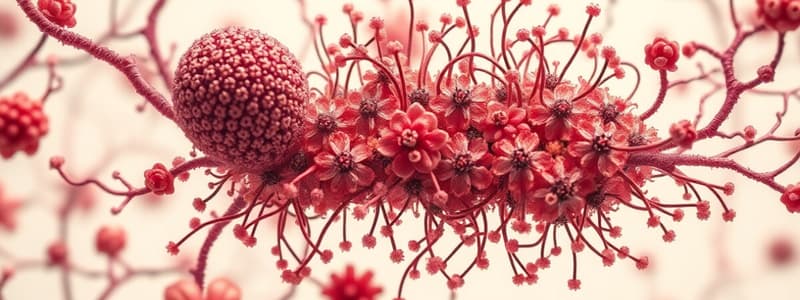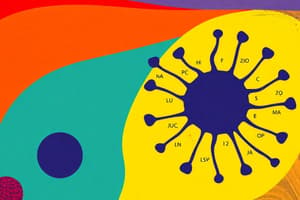Podcast
Questions and Answers
What are the three domains used to classify organisms?
What are the three domains used to classify organisms?
Bacteria, Archaea, Eukarya
What is the name given to the system of scientific nomenclature that uses genus and species?
What is the name given to the system of scientific nomenclature that uses genus and species?
Binomial Nomenclature
Define the process of glycolysis.
Define the process of glycolysis.
Glycolysis is the breakdown of glucose into pyruvate, which generates ATP and NADH.
Endospores are formed by bacteria when they are exposed to harsh environmental conditions.
Endospores are formed by bacteria when they are exposed to harsh environmental conditions.
Which of the following is NOT a product of fermentation?
Which of the following is NOT a product of fermentation?
What are the three basic shapes of bacteria?
What are the three basic shapes of bacteria?
Define total magnification.
Define total magnification.
Match the following types of microscopes with their primary uses:
Match the following types of microscopes with their primary uses:
Flashcards
What is the system of scientific nomenclature?
What is the system of scientific nomenclature?
The system of naming organisms using genus and species, using the Latin binomial system. For example, Escherichia coli
What are the major characteristics of bacteria?
What are the major characteristics of bacteria?
Bacteria are single-celled prokaryotes, lacking a nucleus and complex organelles. They have diverse shapes, sizes, and metabolic abilities. Bacteria can be found in various environments, including soil, water, and the human body.
How do microbes affect our lives?
How do microbes affect our lives?
Microbes play a crucial role in various aspects of human life, including:
- Beneficial roles: food production (fermentation), bioremediation, nutrient cycling, and normal microbiota.
- Harmful roles: causing diseases, food spoilage, and biodeterioration.
What were the contributions of Hooke and van Leeuwenhoek?
What were the contributions of Hooke and van Leeuwenhoek?
Signup and view all the flashcards
What is spontaneous generation?
What is spontaneous generation?
Signup and view all the flashcards
What is biogenesis?
What is biogenesis?
Signup and view all the flashcards
What are Koch's Postulates?
What are Koch's Postulates?
Signup and view all the flashcards
What were the contributions of Pasteur?
What were the contributions of Pasteur?
Signup and view all the flashcards
What were the contributions of Redi?
What were the contributions of Redi?
Signup and view all the flashcards
What were the contributions of Semmelweis?
What were the contributions of Semmelweis?
Signup and view all the flashcards
What were the contributions of Lister?
What were the contributions of Lister?
Signup and view all the flashcards
What were the contributions of Jenner?
What were the contributions of Jenner?
Signup and view all the flashcards
What were the contributions of Koch?
What were the contributions of Koch?
Signup and view all the flashcards
What were the contributions of Fleming?
What were the contributions of Fleming?
Signup and view all the flashcards
What are the three domains used to classify organisms?
What are the three domains used to classify organisms?
Signup and view all the flashcards
What is normal microbiota?
What is normal microbiota?
Signup and view all the flashcards
What are biofilms?
What are biofilms?
Signup and view all the flashcards
What is total magnification?
What is total magnification?
Signup and view all the flashcards
What is parfocal?
What is parfocal?
Signup and view all the flashcards
What is resolution?
What is resolution?
Signup and view all the flashcards
What is refractive index?
What is refractive index?
Signup and view all the flashcards
What is a compound light microscope?
What is a compound light microscope?
Signup and view all the flashcards
What is a darkfield microscope?
What is a darkfield microscope?
Signup and view all the flashcards
What is a fluorescence microscope?
What is a fluorescence microscope?
Signup and view all the flashcards
What is an electron microscope?
What is an electron microscope?
Signup and view all the flashcards
What is a simple stain?
What is a simple stain?
Signup and view all the flashcards
What is a differential stain?
What is a differential stain?
Signup and view all the flashcards
What are the steps in preparing a Gram stain?
What are the steps in preparing a Gram stain?
Signup and view all the flashcards
What are the three basic shapes of bacteria?
What are the three basic shapes of bacteria?
Signup and view all the flashcards
What is the structure and function of the cell wall in bacteria?
What is the structure and function of the cell wall in bacteria?
Signup and view all the flashcards
What is the structure and function of the glycocalyx?
What is the structure and function of the glycocalyx?
Signup and view all the flashcards
What is the structure and function of flagella?
What is the structure and function of flagella?
Signup and view all the flashcards
What is the difference between prokaryotes and eukaryotes?
What is the difference between prokaryotes and eukaryotes?
Signup and view all the flashcards
What is the function of ribosomes?
What is the function of ribosomes?
Signup and view all the flashcards
What are the stages of bacterial growth?
What are the stages of bacterial growth?
Signup and view all the flashcards
What is sterilization?
What is sterilization?
Signup and view all the flashcards
What is disinfection?
What is disinfection?
Signup and view all the flashcards
What is the mode of action of heat sterilization?
What is the mode of action of heat sterilization?
Signup and view all the flashcards
What is the mode of action of filtration sterilization?
What is the mode of action of filtration sterilization?
Signup and view all the flashcards
What is the disk diffusion method for evaluating disinfectants?
What is the disk diffusion method for evaluating disinfectants?
Signup and view all the flashcards
What is the function of the CDC?
What is the function of the CDC?
Signup and view all the flashcards
What are the portals of entry for pathogens?
What are the portals of entry for pathogens?
Signup and view all the flashcards
What is LD50?
What is LD50?
Signup and view all the flashcards
What are invasins?
What are invasins?
Signup and view all the flashcards
How do microbes adhere to host cells?
How do microbes adhere to host cells?
Signup and view all the flashcards
What are exotoxins?
What are exotoxins?
Signup and view all the flashcards
What are endotoxins?
What are endotoxins?
Signup and view all the flashcards
What is the difference between cell-mediated immunity (CMI) and antibody-mediated immunity (AMI)?
What is the difference between cell-mediated immunity (CMI) and antibody-mediated immunity (AMI)?
Signup and view all the flashcards
What are the five classes of antibodies?
What are the five classes of antibodies?
Signup and view all the flashcards
What is a vaccine?
What is a vaccine?
Signup and view all the flashcards
What are the different types of vaccines?
What are the different types of vaccines?
Signup and view all the flashcards
What is Type I hypersensitivity?
What is Type I hypersensitivity?
Signup and view all the flashcards
What is Type IV hypersensitivity?
What is Type IV hypersensitivity?
Signup and view all the flashcards
What is the mechanism of action of antibiotics?
What is the mechanism of action of antibiotics?
Signup and view all the flashcards
What is the Kirby-Bauer method for microbial susceptibility testing?
What is the Kirby-Bauer method for microbial susceptibility testing?
Signup and view all the flashcards
What is the mechanism of drug resistance?
What is the mechanism of drug resistance?
Signup and view all the flashcards
What are the antimicrobial features of the urinary system?
What are the antimicrobial features of the urinary system?
Signup and view all the flashcards
Study Notes
Unit 1: Chapter 1
- Students should be able to recognize the scientific naming system (genus and species) of microorganisms.
- Students should be able to differentiate between the major characteristics of different groups of microbes.
- Students should understand how microbes impact human life.
- Students should know the observations of Hooke and van Leeuwenhoek.
- Students should understand the theories of spontaneous generation and biogenesis.
- Students should understand the contributions of various scientists such as Pasteur, Redi, Semmelweis, Lister, Jenner, Koch, Fleming, and Needham.
- Students should know the three domains used to categorize organisms.
- Students should understand the significance of Koch's Postulates.
- Students should be able to define various terms like normal microbiota, biofilms, bacteria, fungi, algae, protozoa, helminths, and viruses.
Chapter 3
- Students should be able to define total magnification, parfocal, resolution, and refractive index.
- Students should know the different types of microscopes (compound light, darkfield, fluorescence, and electron).
- Students should understand how to compare and contrast Gram and acid-fast stains.
- Students should know other types of special stains.
- Students should know the three basic shapes of bacteria.
- Student should know differences between light and electron microscopy.
- Students should know the parts of a compound light microscope and their functions.
Chapter 4
- Students should understand the structure and function of prokaryotic cell components.
- Students should understand the structure and function of eukaryotic cell components.
- Students should be able to compare and contrast prokaryotes and eukaryotes.
- Students should know the structure and function of the glycocalyx, flagella, axial filaments, fimbriae, pili, plasmids, inclusions, and ribosomes.
- Students should be able to compare and contrast the cell walls of gram-positive and gram-negative bacteria.
- Students should understand the function and formation of endospores.
- Students should know the definition of various terms such as organelles, mitochondria, Golgi body, lysosome, endosymbiotic theory, and the endoplasmic reticulum.
- Students should understand the processes of passive diffusion, facilitated diffusion, osmosis, active transport, and group translocation.
- Students should understand how isotonic, hypotonic, and hypertonic solutions impact bacterial cells.
Chapter 5
- Students should define metabolism and understand the distinctions between anabolism and catabolism.
- Students should understand enzymatic action, factors influencing activity, components, and classifications.
- Students should know oxidation-reduction reactions.
- Students should understand the processes of glycolysis, the Krebs cycle, and the electron transport chain.
- Students should know the meanings of anaerobic, aerobic, fermentation, chemoautotroph, chemoheterotroph, photoautotroph, photoheterotroph, and ribozyme.
- Students should be able to compare and contrast aerobic and anaerobic respiration.
- Students should know the products of fermentation.
- Students should understand the use of biochemical tests to identify bacteria.
Chapter 6
- Students should be able to classify microbes based on preferred temperature ranges.
- Students should understand how pH affects microbial growth.
- Students should understand the role of osmotic pressure in microbial growth.
- Students should know how microbes are classified based on oxygen requirements.
- Students should be able to compare and contrast the growth of anaerobes and microaerophiles.
- Students should understand the formation of biofilms.
- Students should know how media (enriched, selective, differential, reducing) are used.
- Students should be able to describe special culture techniques like using anaerobic jars, candle jars, and cell culture.
- Students should define/understand biosafety levels, proper specimen collection, pure culture, colony, inoculum, streak plate, binary fission, and generation time.
- Students should be able to compare stages of bacterial growth.
- Students should understand direct and indirect methods for measuring cell growth.
Chapter 7
- Students should define sterilization, disinfection, asepsis, antiseptic, sanitation, degerming, commercial sterilization, and pasteurization.
- Students should know methods of sterilization and disinfection, and their mechanisms.
- Students should be able to list factors and uses related to sterilization/disinfection.
- Students should be able to explain the disk diffusion method for evaluating disinfectants.
Chapter 10
- Students should define taxonomy.
- Students should list the characteristics of Bacteria, Archaea, and Eukarya domains of microorganisms.
- Students should compare and contrast classification and identification.
- Students should understand the purpose of Bergey's Manual.
- Students should understand methods of identifying bacteria.
- Students should understand the principles, uses, and processes of agglutination, immunofluorescence, enzyme-linked immunosorbent assays, and western blotting.
Chapter 11
- Students should be able to list six characteristics used to classify and identify bacteria.
- Students should know examples of organisms in different sections such as Spirochetes, Treponema pallidum, Borrelia burgdorferi, Helicobacter pylori, Vibrio cholera, Campylobacter jejuni, Pseudomonas aeruginosa, Legionella pneumophila.
Chapter 12
- Students should be able to list the characteristics of fungi.
- Students should be able to define and give examples of yeasts, molds, and fleshy fungi.
- Students should be able to compare and contrast fungi and bacterial cells.
- Students should describe fungi useful to humans.
- Students should know yeast and fungal infections of humans and their treatment.
- Students should be able to define cyst and trophozoite.
- Students should know the characteristics of protozoa and important protozoan pathogens, including life cycles, diseases, modes of transmission, and treatments.
- Students should understand the definitions of intermediate host, definitive host, and vector.
- Students should understand different characteristics of parasitic helminths.
- Students should know the causative agents, modes of transmission, symptoms, and treatments of different helminthic infections.
Chapter 13
- Students should be able to differentiate between viruses and bacteria.
- Students should describe the chemical and physical structure of enveloped and non-enveloped viruses.
- Students should define viral species, virion, plaques, latency, and cytopathic effect.
- Students should be able to give an example of a virus family, genus, and common name.
- Students should understand how bacteriophages are cultured.
- Students should understand how animal viruses are cultured.
- Students should be able to list three techniques for identifying viruses.
- Students should describe the lytic cycle of T-even bacteriophages.
- Students should describe the lysogenic cycle of Lambda bacteriophages.
- Students should be able to describe the steps of multiplication of RNA and DNA animal viruses.
- Students should be able to describe the symptoms, modes of transmission, prevention, and treatment of several viral infections (Rhinovirus, RSV, Influenzae virus, Mumps, Rubella, Measles, Smallpox, Varicella-zoster, Hepatitis A, B, C, D, and E, Rotavirus, Norwalk, Herpes simplex type I and II, HPV, HIV, Polio, Rabies, Epstein-Barr, and Cytomegalovirus).
- Students should define Creutzfeldt-Jakob disease, Mad Cow disease, and prions.
Chapter 14
- Students should define key terms related to pathology, infection, disease, and immunity (e.g., pathology, etiology, infection, disease, syndrome, normal flora, opportunistic organisms, contagious disease, noncommunicable disease, communicable disease, reservoir of infection, carrier, healthcare-associated (nosocomial) infection, compromised host, epidemiology, and notifiable disease).
- Students should give examples of normal flora.
- Students should review Koch's postulates.
- Students should define herd immunity, occurrence of disease, stages of disease, and duration of disease.
- Students should explain host involvement in disease and predisposing factors.
- Students should be able to describe methods of disease transmission.
- Students should understand the CDC's role in disease prevention and control.
- Students should list reasons for emerging infectious diseases and give examples.
Chapter 15
- Students should know the principal portals of entry for pathogens.
- Students should be capable of defining LD50, ID50, antigenic variation, invasins, and siderophores.
- Using examples, they should understand the mechanisms of microbial adherence to host cells.
- Students should know the four virulence factors of pathogens (adherence, cell wall components, enzymes, and toxins).
- Students should compare and contrast exotoxins (A-B and others), and endotoxins by example.
- They should describe and give examples of the roles of plasmids and lysogeny in pathogenicity.
- Students should know five cytopathic effects of viral infections.
Chapter 16
- Students should be able to describe the role of the skin and mucous membranes in non-specific resistance, distinguishing physical and chemical factors.
- Students should define phagocytosis, phagocyte, differential white-blood cell count, macrophage, and opsonization.
- Students should be able to list the types of white cells.
- Students should describe the stages of phagocytosis, including adherence and ingestion.
- Students should be able to list the stages of inflammation.
- Students should define cytokines and provide examples.
- Students should explain phagocyte migration and emigration.
- Students should describe the stages of phagocytosis and inflammation.
- Students should explain how microbes escape phagocytosis.
- Students should be able to define and explain complement, interferons, and toll-like receptors.
- Students should be able to explain the results of the activated complement.
- Students should explain the results from activated complement (opsonization, cytolysis, and inflammation).
- Students should be able to explain interferons.
Chapter 17
- Students should be able to differentiate between non-specific and specific (adaptive) immunity.
- Students should compare and contrast cell-mediated immunity (CMI) and antibody-mediated immunity (AMI).
- Students should understand the function of antibodies and their structural and chemical characteristics along with the clonal selection theory.
- Students should compare and contrast the five classes of antibodies.
- Students should explain the five ways antibodies react with an antigen and their consequences.
- Students should distinguish between primary and secondary immune responses.
- Students should understand T-cell activation (roles of M cells, TH1, TH2, TH17, regulatory T cells, CTLs, Natural Killer (NK) cells, CD8+, etc).
- Students should know the role of antigen-presenting cells (APCs) and MHC (class I and II) in T-cell activation.
- Students should compare and contrast T-dependent and T-independent antigens.
- Students should contrast the four types of acquired immunity.
- Students should define antigen, antibody, hapten, B-cell, plasma cell, T-cell, apoptosis, monoclonal antibodies, and cytokines (including interleukins and interferon).
Chapter 18
- Students should know the definitions of vaccine, vaccination, attenuated, toxoid, and herd immunity.
- Students should describe the five different types of vaccines (attenuated, inactivated, toxoid, subunit [including recombinant], and DNA).
- Students should give examples of each type of vaccine.
- Students should understand vaccine safety and current issues contributing to decreasing vaccination rates.
Chapter 19
- Students should understand the mechanism of type I and type IV hypersensitivity reactions.
- Students should define immunotherapy and give examples.
- Students should describe the structure and replication of HIV.
- Students should know about HIV transmission, diagnosis, treatment, and prevention.
Chapter 20
- Students should define chemotherapy, chemotherapeutic agents, antibiotics, and synthetic drugs.
- Students should know about the contributions of Ehrlich, Fleming, Chain, and Florey to chemotherapy.
- Students should identify five methods of action of antimicrobial drugs.
- Students should describe an ideal antibiotic.
- Students should describe the mechanisms of action of various antibiotics (penicillin, ampicillin, vancomycin, ethambutol, tetracycline, erythromycin, cephalosporins, aminoglycosides, Polymyxin B, ciprofloxacin, rifampin, sulfonamides, isoniazid).
- Students should understand the Kirby-Bauer and MIC methods for microbial susceptibility testing.
- Students should describe mechanisms of drug resistance (such as MRSA and VRE).
- Students should define synergism and antagonism.
- Students should list factors contributing to microbial resistance to antimicrobial drugs.
Chapter 21
- Students should describe the structure of skin and mucous membranes and how pathogens invade the skin.
- Students should list and describe diseases caused by Herpes, smallpox, measles, varicella-zoster, rubella, Candida albicans, dermatophytes.
- Students should list and describe diseases caused by neonatal ophthalmia, inclusion conjunctivitis, and trachoma.
Chapter 22
- Students should define central nervous system, blood-brain barrier, meningitis, and encephalitis.
- Students should discuss the epidemiology, diagnosis, and treatment of meningitis.
- Students should review/discuss tetanus (mode of transmission, etiology, symptoms, treatment, and prevention).
- Students should review/discuss leprosy, rabies, polio.
- Students should review botulism and C. neoformans meningitis.
Chapter 23
- Students should know the role of the cardiovascular and lymphatic systems in spreading and eliminating infections.
- Students should define and describe septicemia, puerperal sepsis, endocarditis, rheumatic fever, anthrax, gangrene, plague, Lyme disease, Rocky Mountain spotted fever, and infectious mononucleosis.
- Students should review malaria and toxoplasmosis.
Chapter 24
- Students should describe how microorganisms are prevented from entering the respiratory system.
- Students should define and explain pharyngitis, laryngitis, tonsillitis, sinusitis.
- Students should list and describe bacterial and viral causes of upper/lower respiratory infections.
- Students should review fungal causes of upper/lower respiratory infections.
- Students should compare and contrast specific respiratory pathogens based on transmission, symptoms, diagnostic labs, treatment, and prevention.
Chapter 25
- Students should know about microbiota in different parts of the intestinal tract.
- Students should understand events leading to dental caries and periodontal disease.
- Students should know about staphylococcal food poisoning, shigellosis, salmonellosis, typhoid fever, cholera, gastroenteritis, peptic ulcer disease, and mumps.
- Students should know ergot poisoning and aflatoxin poisoning.
- Students should know about various parasitic infections.
- Students should understand why Clostridium difficile is an opportunistic infection.
Chapter 26
- Students should know about the antimicrobial defenses of the urinary system.
- Students should understand portals of entry to the reproductive system.
- Students should know about different infections affecting the reproductive system.
Studying That Suits You
Use AI to generate personalized quizzes and flashcards to suit your learning preferences.
Related Documents
Description
This quiz covers key concepts from Microbiology Unit 1, focusing on the scientific naming system, characteristics of microbes, and significant contributions from famous scientists. It also addresses foundational knowledge from Chapter 3 related to microscopy, including definitions and principles of magnification and resolution.




